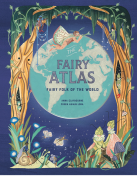
LitPick Review

Fairy Atlas, written by Anna Claybourne and illustrated by Miren Asiain Lora, is a comprehensive overview of fairy folk and their relatives. As mentioned in the title, this book is an atlas that presents commentary from many countries in each of the continents of the world, about fairy myths and legends. After an initial introduction defining the fairy world and fairies, the reader is first taken to Europe and introduced to various fairy creatures (Puck, Brownie, Lutin, Galtzagorri, and more) from England to Hungary.
Through lively vignettes accompanied by a colorful illustration, the author and illustrator provide the reader with brief highlights of the fairy creatures in each country. For example, in Norway, Denmark, and Sweden, the author writes “The Nisse (known as a Tomte in Sweden) is a gnomelike creature who resembles a tiny old man. Despite his small size, a Nisse is incredibly strong and skilled in toolmaking, craftwork, and magic. He is rarely seen because he can make himself invisible.” She then proceeds with a few more sentences educating the reader about where a Nisse lives, what he eats, and how you shouldn’t annoy them by treating animals badly. There is also an accompanying illustration depicting a Nisse kindly feeding hay to a horse.
Overall, the book is like a travelogue, proceeding to enlighten the reader about the numerous fairy creatures in Africa, Asia, Oceania, and North and South America. Scattered among this fairy travelogue are pages where the author and illustrator also provide the reader with more background into the fairy world such as a guide to individual fairy folk such as the fairy, elf, imp, brownie, and pixie. These background pages also present information on fairy traditions, fairy powers, how fairies live among us, fairy signs around us, and fairy sightings. The book concludes with a “fairy guide” that tells the reader what they should do if they find themselves in fairy territory (which seems like everywhere after you read this book…) to “keep the fairies happy and stay safe from fairy magic.”
Opinion:
When you think of fairies, if you immediately think of Tinkerbell in Peter Pan, Cinderella’s Fairy Godmother or even your own Tooth Fairy, then this book is definitely for you. It turns out that “fairy folks” come in all shapes and sizes, with all sorts of personalities, and live pretty much everywhere, all over the world. The book beautifully presents the ubiquitous nature of fairy folk and the text throughout the book is reinforced by clever, imaginative, and colorful illustrations.
I found the atlas engaging on several levels, in addition to providing readers with a unique overview of our world and its vastness. By moving from country to country and continent to continent, the reader travels around the world exploring the fairy world. This travelogue does not just tell us about the fairy folk in each country but it gives us a sense of the vastness and the differences among the world cultures. I found this worldly view to be a very educational aspect of the atlas. Also, through fairies and the fairy tales and myths of each country, one gets a sense of our world’s diversity and complexity in a unique and refreshing way. The wonderful vignettes which describe the fairy in each country, when read one after the other, will also help young readers appreciate the different ways world cultures see not just fairies but the world around them.
Readers will find that all people of the world share common fairy folk tales and myths, although differently named or described. Fairies, whether a Puck in England or a Culupira in Brazil, reflect a common belief in the magical world around us. Hopefully these different perspectives will help these readers to learn to respect cultural differences too. I found that the book, through the myths and tales of fairies, also promotes a theme of kindness. Be kind to one another, be kind to animals, and be kind to nature.
I recommend this book for parents of children ages 8 – 12 and for young adults interested in myths and the magical world around us, and even adults who still believe in magical creatures like fairies and how they can explain the unexplainable in life. Oh, by the way…maybe this book is for you too? After all, when is the last time you looked under your bed or in your garden for a fairy?


